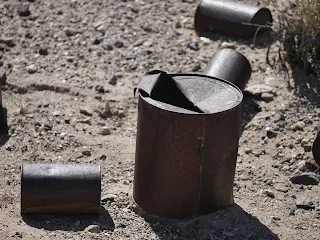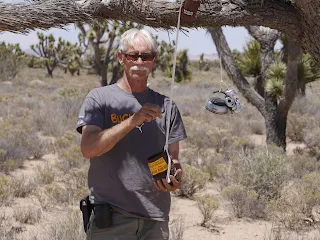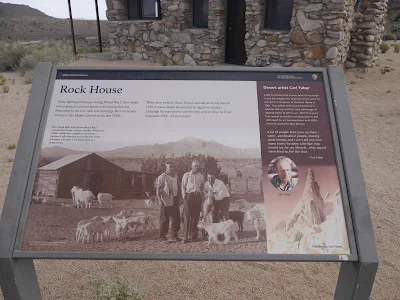The Fourth day on the Mohave Road started with
little sleep.
A million mosquitoes from the Mojave River just to the southeast
of the Afton Canyon campground kept the arms sweeping the air all night. That
is not a way to sleep. Even a zippered tent didn’t alleviate the need of
the flaying of the appendages. Each time one of the two boys went out of the
tent seemed like a siege was going on with the annoying little flying beasts.
Zip the door open and dozens of mosquitoes flew into the
tent. OFF – GET OUT – and – WHAT THE HELL! was sprayed in the air and every crevice of the body but to no avail.
 |
| I just need the restroom |
Three in the morning found John rinsing his mouth with bits of chewed mosquitoes flowing out.
No photos here - obviously!
Gross – yes – it’s an adventure right? No, it was
just disgusting.
The sun rose and so did two very tired guys. A quick
breakfast while being chased around by two of the largest wasps known to
mankind made the early morning that much less cheerful.
On the road – thankfully.
 |
| Road looking good from the passenger's side view |
Through the years it was manned by soldiers, abandoned, manned by soldiers and then abandoned completely in 1871. We needed to find the spot where this mainstay of the Mojave Road had been crucial to soldiers and pioneers as well.
But there was a problem.Trying to figure out how to get out of the Mojave River and locate the Manix Wash and up onto firm land. Easy - just follow the deep sand, hang a right on the wash and it's done. Oops, the river bed ended suddenly into tightly knit channels which offered no way out of the river bed.
Four days and this is was how it was to end? Back track - not even in the equation.
One more try up a dry wash west and suddenly there was a dirt
track jumping out at us. It was the Manix Wash. We smiled.
Two hours later the old site of
Fort Cady could not be found. It's like Fort Mojave - is it there or there?
Who knows but sometimes being near is as good as being there.
Tired, dirty and ready for some sleep, a good meal and just all around relaxing the boys decided to spend the last night at a KOA in Yermo. Pool, showers, snack shop and shade. What else did they need?
A good cigar - a cold beverage and the trip was over. Wonderful experience but an eye opener when traveling in the desert of the southwest.
 |
| Okay - where was this marker? Taken from the internet. |
Who knows but sometimes being near is as good as being there.
Tired, dirty and ready for some sleep, a good meal and just all around relaxing the boys decided to spend the last night at a KOA in Yermo. Pool, showers, snack shop and shade. What else did they need?
A good cigar - a cold beverage and the trip was over. Wonderful experience but an eye opener when traveling in the desert of the southwest.
 |
| Pool, showers, and shade - it was Heaven after 4 days of none of the mentioned. |
· * Realize
that sites aren’t always to be found – the general area is good enough many
times. It’s the adventure that counts.
· * Bring
plenty of supplies when traveling in the remote wilderness – overkill is not a
thing to be ashamed of.
· * Be
prepared for an event which can turn lethal – sort of like the above point.
· * Don’t
travel alone on the Mojave Road – Casebier says that is not a good idea in his
guidebook. It’s not.
· * Carry
good maps and a GPS.
· * Don’t
drive like a ‘Ricky Racer’ – the road or path dictates the speed not the mind.
· * Slow
down and enjoy the scenery – there is so much to see and witness.
· At
night look up into sky – there’s a lot of stars up there.
· * The
deserts of Southern California are gorgeous and full of life.
· Just
remember – time on this planet is short so get out there and explore it.














































